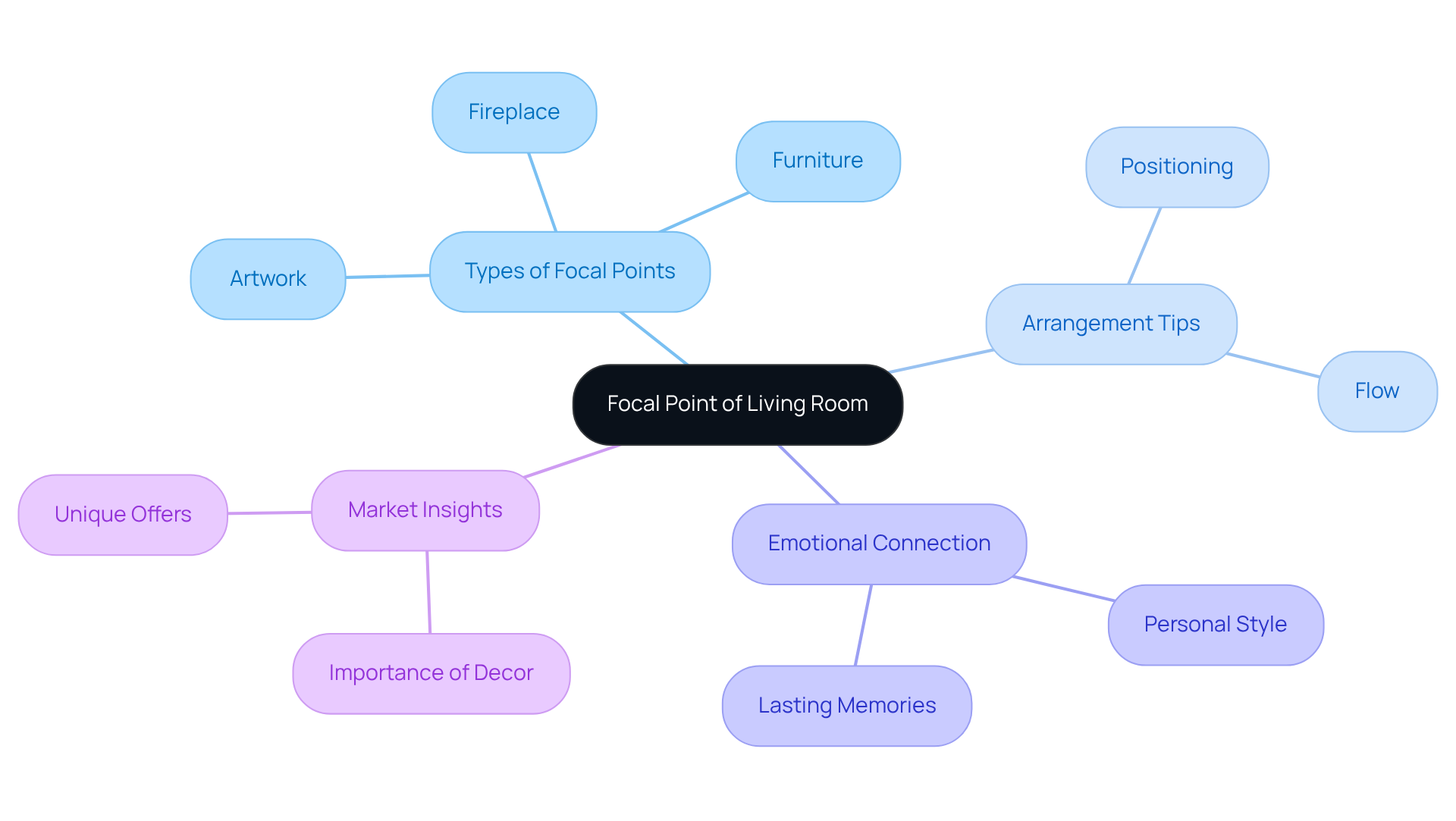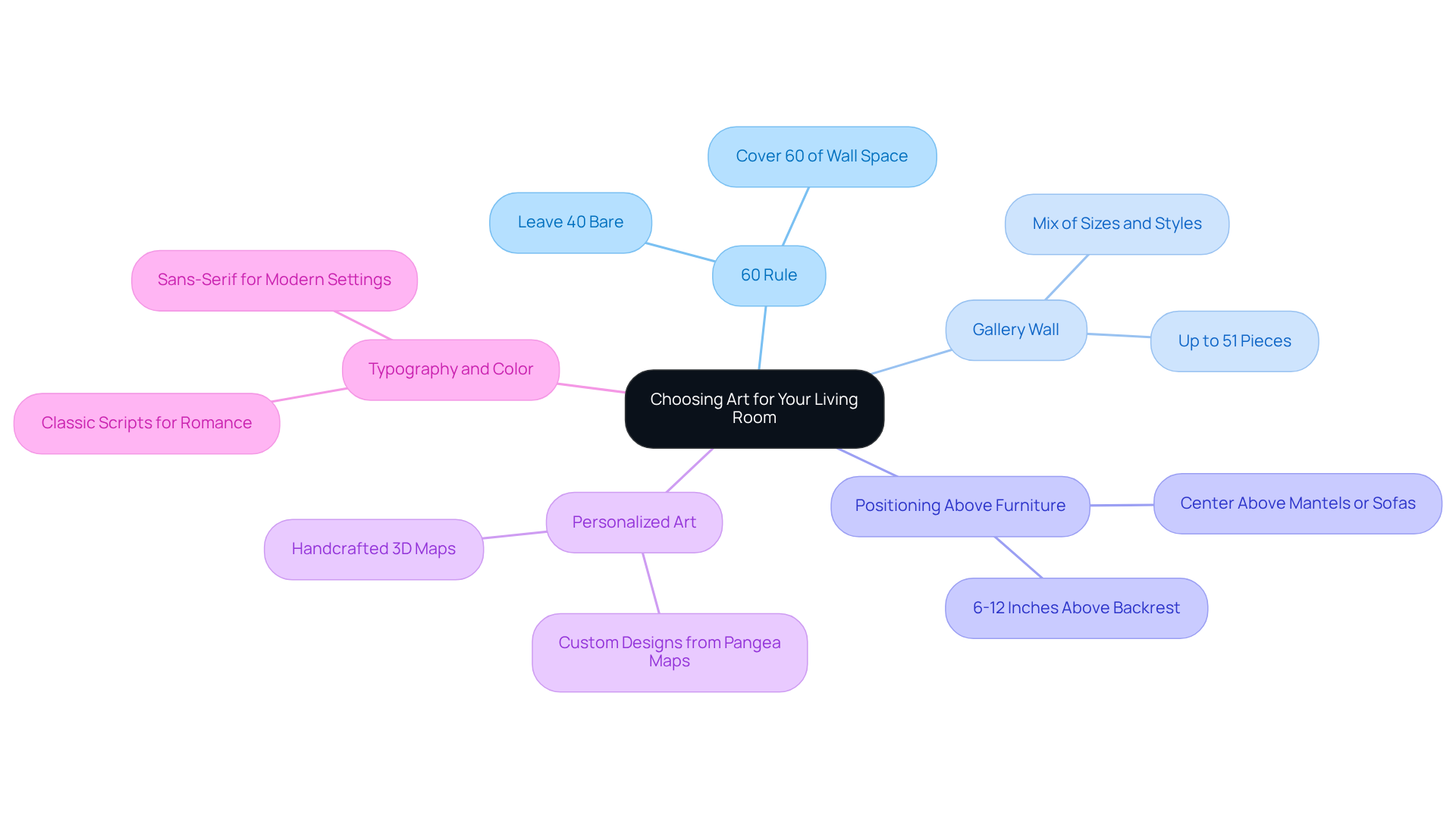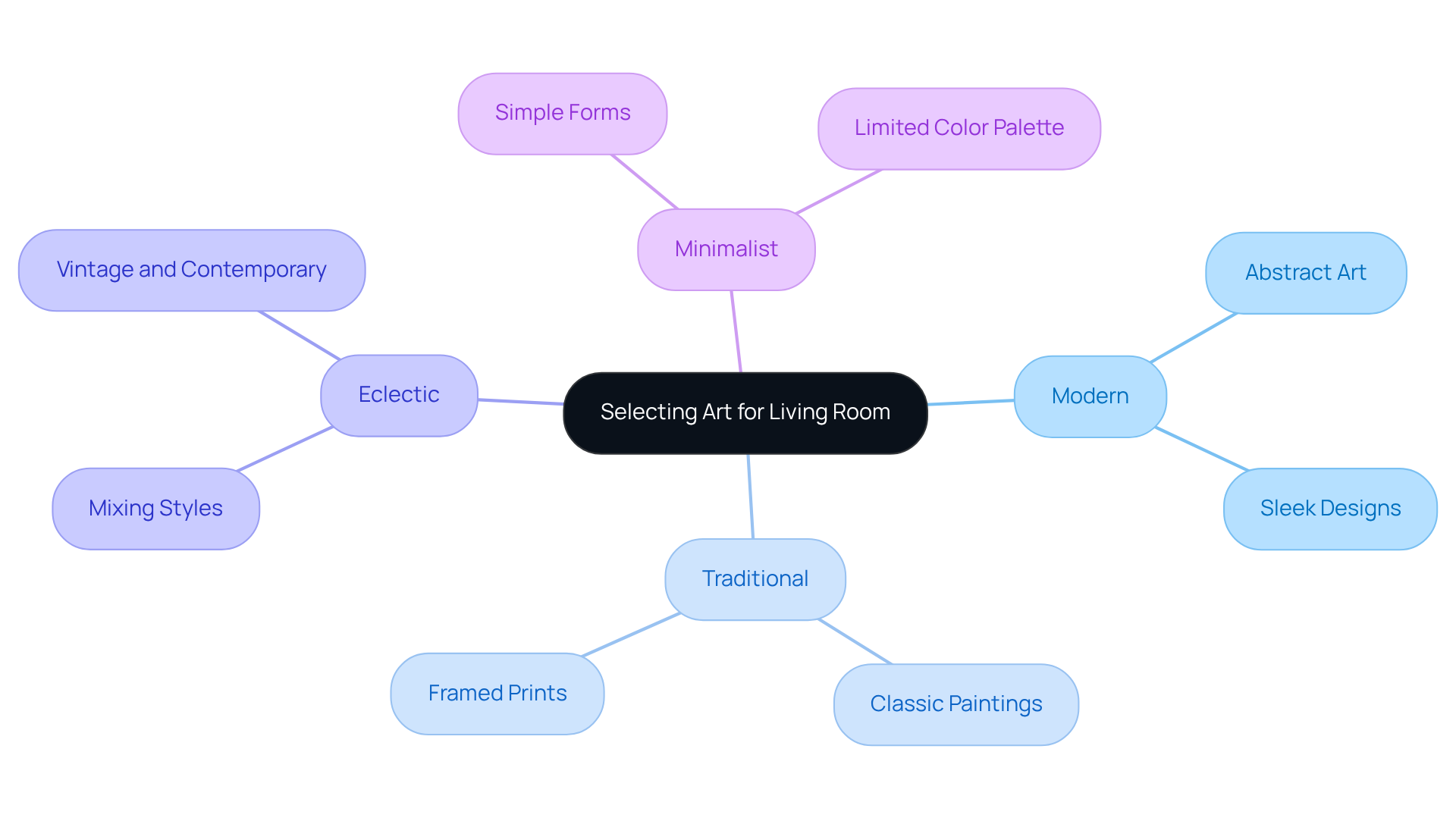Overview
Choosing art for living room decor is not merely an aesthetic choice; it is a strategic decision that involves:
- Identifying a focal point
- Selecting the appropriate size and layout
- Considering the color scheme
- Aligning art styles with personal taste
These elements are crucial for creating a harmonious and inviting space. They establish visual interest and emotional connections, reflecting individual style and ultimately enhancing the overall aesthetic of the living room. By carefully curating art, you transform your living area into a reflection of your unique story, handcrafted with care.
Introduction
Selecting art for living room decor transcends mere decoration; it serves as a powerful opportunity to express personal style and cultivate a welcoming atmosphere. In a flourishing home decor market, mastering the art of choosing the right pieces can elevate a space from ordinary to extraordinary.
However, with a myriad of options at one's disposal, how does one adeptly navigate the intricacies of size, color, and style to achieve a cohesive look?
This article explores essential tips for selecting art that not only enhances the living room but also resonates with individual tastes and preferences.
Identify the Focal Point of Your Living Room
To create a harmonious space, begin by identifying a focal point—this could be art for the living room, an engaging piece of artwork, an eye-catching item of furniture, or even a fireplace. This focal point should attract attention and set the atmosphere of the space. For instance, if you choose a large painting, position it at eye level to maximize its visual impact. Arrange your furniture to enhance the prominence of this focal point, fostering a natural flow that encourages conversation and interaction among guests.
As noted by interior decorators, a clearly defined focal point not only organizes the area but also enhances the overall appearance, creating a welcoming atmosphere. Refreshing accessories around this focal point consistently can maintain a fresh and inviting feel, showcasing your personal style while enhancing the emotional connection to the space with art for the living room.
With the global home decor market valued at USD 747.75 billion in 2024, investing in thoughtful decor choices is more crucial than ever. Art for the living room, such as the artisanal handcrafted 3D maps from Pangea Maps, serves as a stunning focal point, forging emotional connections and creating lasting memories. These custom designs, featuring hand sketches over bathymetry charts, not only narrate your story but also add a unique touch to your decor. Pangea Maps offers over 1,000 designs, each crafted with care, and ships within 4-6 days.
As interior designer Akhil Singh states, 'Focal points thrive on contrast,' emphasizing the need for intentionality in design. Be mindful of the potential pitfalls of having multiple focal points, as this can lead to confusion in your design choices.

Choose the Right Size and Layout for Art
When selecting art for the living room, it is essential to consider both the size of the wall and the surrounding furniture. A widely accepted guideline, known as the '60% Rule,' indicates that artwork should occupy approximately 60% of the available wall space, leaving 40% bare to create a balanced and harmonious aesthetic.
For larger walls, a gallery wall featuring a mix of sizes and styles can significantly enhance visual interest and depth; indeed, a gallery wall can comprise up to 51 different prints, photographs, and original pieces. Smaller pieces can be effectively grouped to form a cohesive display, ensuring that the layout allows for easy viewing and enhances the overall design of the space.
For instance, if you have a sectional sofa, position the art slightly above the backrest, ideally 6-12 inches above, to create a unified and inviting look. Remember, as Sarah Thompson aptly states, 'Every sitting area is a vibrant narrative,' so choose art for the living room that tells your story.
Consider incorporating personalized handcrafted 3D maps by Pangea Maps, which feature custom designs that capture significant stories and memories. These maps are not only visually striking but are also crafted from environmentally sourced materials, adding a unique touch to your decor.
Furthermore, the typography and hue of the artwork play a vital role in enhancing the decor of the space and promoting a sense of warmth and character, making your area feel more like home.

Consider the Color Scheme of Your Living Room
When selecting art for living room, evaluating the current palette is essential. In areas adorned with neutral tones, introducing vibrant art for living room creates a striking contrast that energizes the space. Conversely, if your decor is already colorful, opt for art for the living room that incorporates similar hues to maintain visual harmony. Utilizing the hue wheel can be advantageous; complementary hues generate a dynamic effect, while analogous shades foster a tranquil atmosphere. For instance, in a lounge with a blue and gray palette, art for living room that highlights shades of blue complemented by gold or white effectively unifies the area.
Statistics reveal that hues significantly influence consumer preferences in home decor, with blue being the most favored shade globally, chosen by 42% of individuals. This preference underscores the importance of selecting art that aligns with personal tastes while enhancing the overall aesthetic of the space. Furthermore, 84.7% of individuals state that hue is the primary reason for purchasing a particular product, emphasizing the essential role hue plays in art selection. As noted by color theory specialists, deliberate selections in art not only enhance decor but also evoke specific feelings, transforming the space into a more welcoming and delightful atmosphere. Moreover, 39% of users appreciate hues on a company website, highlighting the broader significance of shades in branding and design.

Align Art Styles with Personal Taste and Decor
When selecting art for living room, it is essential to express your personal style and the overall decor theme. Your aesthetic may lean towards modern, traditional, eclectic, or minimalist; choose pieces that resonate with your unique taste. For example, if your decor features clean lines and a minimalist approach, opt for abstract art characterized by simple forms and a limited color palette. On the other hand, if your style is more eclectic, embrace the opportunity to mix various art styles and mediums. Combine vintage prints with contemporary pieces to create a distinctive gallery wall.
Consider the artisanal handcrafted 3D maps from Pangea Maps, designed to celebrate your adventures and memories. These maps feature custom designs hand-sketched over bathymetry and framed locally, crafted from the highest grade 1.5mm birch ply and topped with white acrylic. Each piece is a testament to quality and sustainability, meticulously designed to capture your unique story.
Ultimately, the art for living room you choose should evoke emotions and reflect who you are, creating a space that feels both personal and inviting. Explore the possibilities with Pangea Maps and transform your space into a true reflection of your individuality.

Conclusion
Selecting the ideal art for your living room decor requires a deliberate strategy that merges personal expression with fundamental design principles. Establishing a definitive focal point, choosing the right size and layout, considering the color scheme, and aligning art styles with personal taste are essential steps to crafting a harmonious and inviting space that genuinely reflects your identity.
Key insights underscore the necessity of:
- Defining a focal point to enhance the room's atmosphere and flow
- Adhering to the '60% Rule' for art sizing
- Utilizing color theory to select pieces that either contrast or complement existing hues
Furthermore, embracing your unique style fosters an aesthetic that transforms the living room into an authentic reflection of oneself.
Ultimately, the art selected for your living room should not only enhance the visual appeal of the space but also evoke emotions and narrate a story. By implementing these strategies and insights, you can curate a living environment that is both visually captivating and profoundly personal—a space where memories are created and cherished.
Frequently Asked Questions
What is a focal point in a living room?
A focal point in a living room is an element that attracts attention and sets the atmosphere of the space, such as art, an engaging piece of furniture, or a fireplace.
How should I position a focal point to maximize its impact?
To maximize the impact of a focal point, position it at eye level, especially if it is a large painting or artwork.
How can I arrange my furniture around the focal point?
Arrange your furniture to enhance the prominence of the focal point, fostering a natural flow that encourages conversation and interaction among guests.
Why is having a clearly defined focal point important?
A clearly defined focal point organizes the area and enhances the overall appearance, creating a welcoming atmosphere.
How can I refresh the look of my living room while maintaining the focal point?
Refreshing accessories around the focal point consistently can maintain a fresh and inviting feel, showcasing your personal style and enhancing the emotional connection to the space.
What is the significance of the global home decor market?
The global home decor market is valued at USD 747.75 billion in 2024, making thoughtful decor choices increasingly important.
What types of art can serve as a focal point in a living room?
Art for the living room, such as artisanal handcrafted 3D maps from Pangea Maps, can serve as a stunning focal point, adding a unique touch and forging emotional connections.
How does Pangea Maps contribute to home decor?
Pangea Maps offers over 1,000 custom designs featuring hand sketches over bathymetry charts, which narrate personal stories and create lasting memories.
What should I consider regarding multiple focal points in a room?
Be mindful of having multiple focal points, as this can lead to confusion in your design choices. A single well-defined focal point is more effective.
What does interior designer Akhil Singh say about focal points?
Interior designer Akhil Singh states that 'focal points thrive on contrast,' highlighting the need for intentionality in design.


